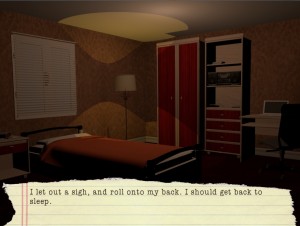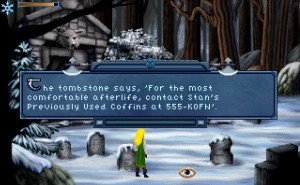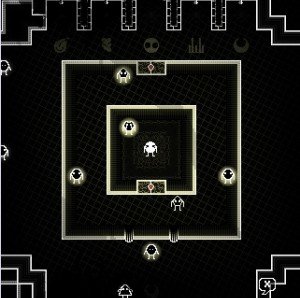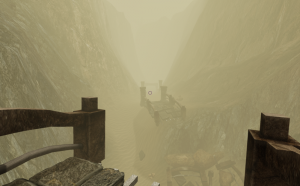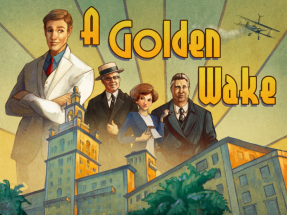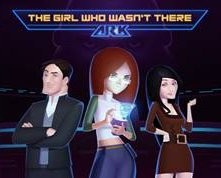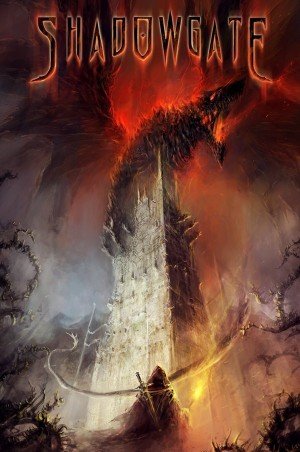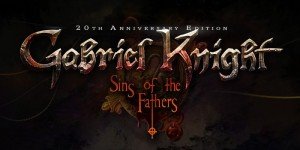Five Years of Following Freeware: Year Four

As we work backwards towards present day, our five-year Following Freeware anniversary extravaganza reaches 2013-2014. For those joining in late, be sure to check out our Year One, Year Two, and Year Three recaps to get up to speed.
August 2013 – Socrates Jones: Pro Philosopher by Chief Wakamakamu
The Ace Attorney series has allowed players to be courtroom dynamos, though not in any courtroom I’d ever like to end up in for real. Socrates Jones: Pro Philosopher takes the essential mechanics of those games but applies them to an entirely different arena. When a salesman comes calling, Socrates almost finds himself convinced by the pitch. Fortunately, his daughter is a philosophy student who teaches him the basics of philosophical debate to challenge this man’s assertions. This tutorial leaves her late for school, so the pair drive off at speed. A subsequent accident propels them into the afterlife in the form of the Intelligible Realm, last resting place of philosophers.
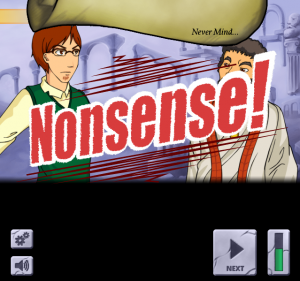 The rest of the game has you debating with famous philosophers from the past on the nature of morality. All of the opposing characters are real, though having actually heard of Euthypro of Athens or Immanuel Kant is not vital for play. The debates are both witty and thought-provoking, as each tries to convince you that their view on the matter is the correct one. Phoenix Wright’s famous cry of “Objection!” is replaced here by “Nonsense!” but you will need to probe arguments carefully before you can make this outburst. Whilst the gameplay is clearly not original, its application is perfect in one of the few medium-length games I felt compelled to play through to its conclusion.
The rest of the game has you debating with famous philosophers from the past on the nature of morality. All of the opposing characters are real, though having actually heard of Euthypro of Athens or Immanuel Kant is not vital for play. The debates are both witty and thought-provoking, as each tries to convince you that their view on the matter is the correct one. Phoenix Wright’s famous cry of “Objection!” is replaced here by “Nonsense!” but you will need to probe arguments carefully before you can make this outburst. Whilst the gameplay is clearly not original, its application is perfect in one of the few medium-length games I felt compelled to play through to its conclusion.
You can cry “Nonsense!” and prove your debating credentials online over on Kongregate.
September 2013 – The House by Artur Kot
Often when putting the Following Freeware articles together I find games that I think are worth sharing but don’t fit the criteria. Usually, if they at least have some relevance, these will appear as one-line descriptions in the “Other games” section at the end. Less often I will do a full write-up, but put them lower in the article, so as not to overshadow more traditional adventures released that month. Such was the case with The House, a game with a beautiful artistic style but probably too abstract to be considered a proper adventure.
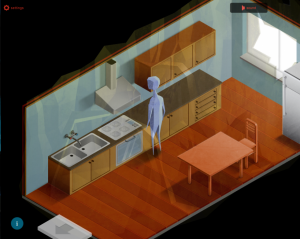 You play a featureless character, trapped in a bizarre house. The graphics are rendered in a high-resolution isometric style, with the strangeness of the character model at odds with the realism of the house contents. Not that the house is entirely normal, apparently floating in thin air and containing an aquarium that allows you to step directly into it. The puzzles are well thought out and extremely satisfying to solve, with only the overly abstract nature of the story keeping it out of a more prominent article spot. Yet two years later, this is the one that sticks with me as being the most notable release of that month.
You play a featureless character, trapped in a bizarre house. The graphics are rendered in a high-resolution isometric style, with the strangeness of the character model at odds with the realism of the house contents. Not that the house is entirely normal, apparently floating in thin air and containing an aquarium that allows you to step directly into it. The puzzles are well thought out and extremely satisfying to solve, with only the overly abstract nature of the story keeping it out of a more prominent article spot. Yet two years later, this is the one that sticks with me as being the most notable release of that month.
If you fancy exploring an extremely peculiar house, it can be found online over at Newgrounds.
October 2013 – Monty the Komodo Dragon by Fitz
It is always a lot easier to get into a game if the player character has a clear goal from the outset. You could be a young man who wants to be a mighty pirate, an archaeologist seeking a lost treasure, or a reaper aiming to meet quota. In Monty the Komodo Dragon, the lead character just wants to provide food for his family. This is probably the most normal thing about the game, however, with almost every other aspect being decidedly surreal.
 The graphics are done in a photomontage style, and some unusual elements have been chosen. The sun up in the sky is an egg, and the body of water Monty must cross is made up of earthworms. Indeed, Monty himself walks on two legs rather than the more normal four a Komodo dragon uses. Conversations with his family are in the form of picture bubbles. Their abrupt nature, and the harshness of the hissing that backs up this “speech”, implies Monty is somewhat put upon. Fans of serious of adventures should steer clear but if, like me, you enjoy delving into the surreal once in a while then this is a game for you.
The graphics are done in a photomontage style, and some unusual elements have been chosen. The sun up in the sky is an egg, and the body of water Monty must cross is made up of earthworms. Indeed, Monty himself walks on two legs rather than the more normal four a Komodo dragon uses. Conversations with his family are in the form of picture bubbles. Their abrupt nature, and the harshness of the hissing that backs up this “speech”, implies Monty is somewhat put upon. Fans of serious of adventures should steer clear but if, like me, you enjoy delving into the surreal once in a while then this is a game for you.
You too can search for food on a sea of worms by taking a trip over to the AGS database.
November 2013 – The Loop by Gliese Productions
As a general rule, we don’t cover visual novels in our monthly round-ups. The main reason for this is that player interactivity is normally very limited. You read a big chunk of text and are then given a single decision that will nudge the story a bit. At first sight, The Loop looked like it would be just another linear visual novel. However, Gliese Productions saw that the programming language used in the Ren’Py engine allowed something much more complex and capitalised on the opportunity. The result is a nightmarish tale of a demonic clown with whom you seem to be trapped in a series of dream-like loops.
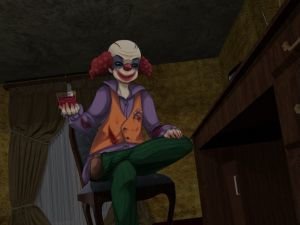 This is not a game for the faint-hearted, as the clown is a truly disturbing foe. You will also need a modicum of dexterity, as there are a couple of sections where the clown pursues you and only by acting quickly can you hope to progress. In these scenarios, the ability to backtrack and repeat actions when necessary further sets it apart from the normal visual novel. Death leads to a reset of the loop, though knowledge from previous loops allows you to progress faster. The story proves pleasingly complex as well, with the motivations of your antagonist being revealed over the course of the game. Be sure to take some notes as you go along, as you will need to demonstrate knowledge of what is going on to advance to the final scenes.
This is not a game for the faint-hearted, as the clown is a truly disturbing foe. You will also need a modicum of dexterity, as there are a couple of sections where the clown pursues you and only by acting quickly can you hope to progress. In these scenarios, the ability to backtrack and repeat actions when necessary further sets it apart from the normal visual novel. Death leads to a reset of the loop, though knowledge from previous loops allows you to progress faster. The story proves pleasingly complex as well, with the motivations of your antagonist being revealed over the course of the game. Be sure to take some notes as you go along, as you will need to demonstrate knowledge of what is going on to advance to the final scenes.
If you want to see something different done within the visual novel format, you can download this game from the developer’s website.
December 2013 – Heroine’s Quest: The Herald of Ragnarok by Crystal Shard
A number of good freeware developers go on to develop commercial games. I grumble good-naturedly about this, bemoaning the fact that I won’t have their games to enjoy for future articles. In reality I am pleased when those who have demonstrated such skill in freeware go on to make a living from that ability. Then I come across a game like Heroine’s Quest: The Herald of Ragnarok and I question why the developers are not already making a living from their work. When the imminent release of the game was announced at Adventure X 2013, I found I wasn’t the only one. When asked how much they were selling it for, the answer that it was free was met with stunned silence.
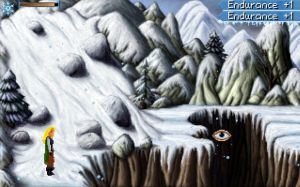 This is a truly epic adventure-RPG hybrid, made in the style of the classic Quest for Glory games. You start off as a weak character, having lost all your equipment and almost your life in an avalanche. Neither the avalanche nor the particularly heavy winter that has befallen the area are simple acts of nature. Dark forces are at work, and you must travel across many realms to thwart them. The production values are stunning. Every character is voiced, and they all have full personalities and lives independent of your actions. There is also a full orchestral soundtrack which changes according to your locale and other events. The game isn’t satisfied with just having its grand story based around one hero. Three character options are available, each offering its own style of play, and there are even side quests to take on. It’s not a pure adventure due to the unavoidable combat element, though the difficulty of this can be scaled up and down as desired.
This is a truly epic adventure-RPG hybrid, made in the style of the classic Quest for Glory games. You start off as a weak character, having lost all your equipment and almost your life in an avalanche. Neither the avalanche nor the particularly heavy winter that has befallen the area are simple acts of nature. Dark forces are at work, and you must travel across many realms to thwart them. The production values are stunning. Every character is voiced, and they all have full personalities and lives independent of your actions. There is also a full orchestral soundtrack which changes according to your locale and other events. The game isn’t satisfied with just having its grand story based around one hero. Three character options are available, each offering its own style of play, and there are even side quests to take on. It’s not a pure adventure due to the unavoidable combat element, though the difficulty of this can be scaled up and down as desired.
Despite the surprised reaction it elicits, this game continues to be available for free. Grab it from one of the links on the developer’s website before they change their mind.
January 2014 – Ossuary: The Hodge-Podge Transformer by Future Proof Games
Demos are, by their very nature, free. Usually they are just a small part of the full game, however, and therefore don’t work on their own. Ossuary: The Hodge-Podge Transformer is an exception to this rule. Whilst it serves very effectively in conveying the look and feel of the full Ossuary, it is also a legitimate adventure in its own right. In this game you enter a strange philosophical world that provides interesting challenges for those willing to grasp its weird logic. Trapped in a peculiar dimension, your only means of escape is activating the eponymous Transformer. Acquiring all the necessary elements to do so is your quest.
 This is certainly not the prettiest of games, adopting a black and white colour scheme and simple line-drawn graphics for most things. But with just enough detail to recognise important items and varied character portraits for conversations, this simple style actually proves quite effective. Despite having a relatively small area to work in, a large number of puzzles are crammed into it. With five major elements to find in order to progress to your intended destination (the setting of the full commercial game), there is a lot more to do here than in most demos.
This is certainly not the prettiest of games, adopting a black and white colour scheme and simple line-drawn graphics for most things. But with just enough detail to recognise important items and varied character portraits for conversations, this simple style actually proves quite effective. Despite having a relatively small area to work in, a large number of puzzles are crammed into it. With five major elements to find in order to progress to your intended destination (the setting of the full commercial game), there is a lot more to do here than in most demos.
Should you wish to enter the Transformer yourself, you can do so over at the developer’s website.
February 2014 – Freja and the Sequel by Biscuit Placebo
When a game is really good, it is easy for the player to find themselves lost in its world. Freja and the Sequel takes that feeling very literally. A long-time fan of the “Crystal Raven” series of games, Freja is delighted to get an interview at the studio that makes them. When a man with a bomb interrupts her interview to demand a sequel, Freja is placed in charge of its development. She soon finds herself slipping between the reality of the game studio and the fantasy world of the games themselves, though she is surprisingly relaxed about it.
 The resulting game is a surreal meta experience. The graphics feature a simple cut-out art style, with character faces that only have eyes. These characters seem equally at home in the sparse modern offices of the game company and the dank cavern homes of the goblins. Puzzles are on the decidedly odd side, including one where you have to determine the exact shade of black of the interior of a dungeon. Fantasy puzzles can be resolved by making use of your colleagues’ technical expertise, such as the colour code for a particular shade of grey. The two worlds also affect one another in inexplicable ways. If you prefer your adventures realistic, then this isn’t a game for you, but if you enjoy the funny and strange from time to time, you’ll want to check this one out.
The resulting game is a surreal meta experience. The graphics feature a simple cut-out art style, with character faces that only have eyes. These characters seem equally at home in the sparse modern offices of the game company and the dank cavern homes of the goblins. Puzzles are on the decidedly odd side, including one where you have to determine the exact shade of black of the interior of a dungeon. Fantasy puzzles can be resolved by making use of your colleagues’ technical expertise, such as the colour code for a particular shade of grey. The two worlds also affect one another in inexplicable ways. If you prefer your adventures realistic, then this isn’t a game for you, but if you enjoy the funny and strange from time to time, you’ll want to check this one out.
Stepping into a peculiar game world is as easy as stepping over to the developer’s website and downloading the game.
March 2014 – Bickadoodle by Aetheric Games
The classic storylines have endured for a reason. Who can resist a tale of a princess in a tower and a knight coming to rescue her? At least, that is how it looks like things are headed at the outset of Bickadoodle. Things take a decidedly unusual turn, however, when the dragon ends up kidnapping the knight instead of the princess. Not one to be denied her happy ending, the princess sets out on a quest to rescue him. The subsequent tale of noble deeds and bravery is very much tongue-in-cheek, and done with a lot of style.
 I love the visual design of this game. The animations are presented with a background like lined notepaper. Whilst detailed, the graphics also have a slightly hurried feeling to them, with stick figure characters and uneven architecture. The result is that, apart from being animated, the game looks like a series of doodles a bored student might draw. The story is definitely the sort of flight of fancy that you’d expect someone to come up with when daydreaming in class. Throw in the “full audio mumbling” speech (meanings being conveyed with picture bubbles) and a great soundtrack and you end up with a piece of lighthearted fun.
I love the visual design of this game. The animations are presented with a background like lined notepaper. Whilst detailed, the graphics also have a slightly hurried feeling to them, with stick figure characters and uneven architecture. The result is that, apart from being animated, the game looks like a series of doodles a bored student might draw. The story is definitely the sort of flight of fancy that you’d expect someone to come up with when daydreaming in class. Throw in the “full audio mumbling” speech (meanings being conveyed with picture bubbles) and a great soundtrack and you end up with a piece of lighthearted fun.
Becoming a brave damsel rescuing a knight in distress is easy. Just head on over to the developer’s website to download the game.
April 2014 – Dreaming Mary by Dreaming Games
You should never judge a book by its cover, or a game by the graphics of its opening scenes. Dreaming Mary is a prime illustration of this maxim. The opening scenes are of a fluffy pink dream world, inhabited by a pretty little girl and her anthropomorphic animal friends. In fact, but for a mildly disconcerting encounter near the end, it is possible to play through the entire game thinking this a happy tale. You might even think that it is a suitable game for little children to play. Let me assure you that this is most definitely not the case.
 You see, Mary has a reason for hiding away in this brightly coloured dream world, and it is not a very pleasant one. The apparently happy ending is only the first of four. The second is also attainable without too much digging, and will give you some idea of what is wrong. To get the full and darker endings, including one that could be considered “good” (though still not exactly jolly), will require a bit more diligence. Each ending is a proper conclusion in its own right, but you are given the option to continue after each one. Doing so restarts the game, but keeps track of the endings you have achieved. Taking note of subtle new clues in subsequent replays, you will unlock hidden areas that Mary would probably prefer to avoid. But if you are prepared to deal with a truly disturbing tale, then that effort is worth making. This is a game with true emotional impact, and one that mainstream games are less ready to cover.
You see, Mary has a reason for hiding away in this brightly coloured dream world, and it is not a very pleasant one. The apparently happy ending is only the first of four. The second is also attainable without too much digging, and will give you some idea of what is wrong. To get the full and darker endings, including one that could be considered “good” (though still not exactly jolly), will require a bit more diligence. Each ending is a proper conclusion in its own right, but you are given the option to continue after each one. Doing so restarts the game, but keeps track of the endings you have achieved. Taking note of subtle new clues in subsequent replays, you will unlock hidden areas that Mary would probably prefer to avoid. But if you are prepared to deal with a truly disturbing tale, then that effort is worth making. This is a game with true emotional impact, and one that mainstream games are less ready to cover.
To delve into the darker side of the world of dreams, download the game from the developer’s website.
May 2014 – RoonSehv by Babel Studio
The Myst series is one that has long divided the adventuring community. It seems there is no middle ground, with people either loving or hating it. Since it was explicitly created as a new world in the Myst mythos, RoonSehv is likely to elicit the same reaction. Those who favour these sorts of games are in for a treat, as the designers have gone all out in recreating the original style with a modern look. Making full use of the Unreal Development Kit to create a real-time 3D environment, this is a self-described labour of love that appears to have achieved its aims. The finishing touches weren’t put on the full version for another year, but an impressive demo gave us a substantial first glimpse of this long-in-development fan creation.
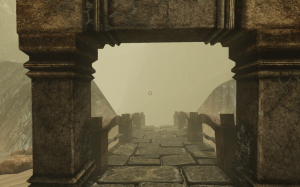 Given that the game was always intended to be free, the realism of the graphics is amazing. In the desert where you start the game, sand blows in the wind. In a nearby hidden valley, plants bedeck the fallen rocks. The sound production is top-notch as well. The location of operating machinery can be tracked based on the volume and direction of the sound it makes. The game also has a very pleasant Arabian soundtrack that fits the setting well. Myst fans will not be disappointed with the puzzles either, which can be just as challenging as their forebears. The quality is akin to that you’d find in many commercial productions, and just further astonishing proof that “free” does not mean poorly made.
Given that the game was always intended to be free, the realism of the graphics is amazing. In the desert where you start the game, sand blows in the wind. In a nearby hidden valley, plants bedeck the fallen rocks. The sound production is top-notch as well. The location of operating machinery can be tracked based on the volume and direction of the sound it makes. The game also has a very pleasant Arabian soundtrack that fits the setting well. Myst fans will not be disappointed with the puzzles either, which can be just as challenging as their forebears. The quality is akin to that you’d find in many commercial productions, and just further astonishing proof that “free” does not mean poorly made.
Myst fans can explore this new Age by downloading the game from the developer’s website.
June 2014 – SCRAP by DividebyZer0team
One thing I’ve always enjoyed about freeware games is that they often use ideas that might be tough to make commercial. Such is the case with SCRAP, where the player character is a Roomba automatic vacuum cleaner trying to find its way home. Neither the protagonist nor the quest are the stuff of grand adventure, but the resulting tale is an enjoyable one. It’s hard to imagine that you could start to feel for a machine, but this game managed to achieve that for me. I truly empathised with this little device struggling to do its duty, and felt invested in seeing it safely through.
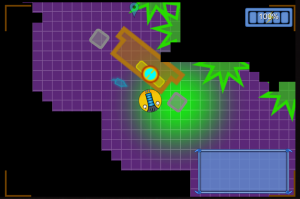 The story begins as the little machine finds itself in an unfamiliar location: a scrap-heap, its owners having thrown it away. Unaware of the reason for its displacement, the machine sets about mapping its nearby environment seeking the way to familiar territory. The graphical representation of this process is a simple line-drawn grid in top-down view. This is uncovered by a key-tap that activates a quick scan of the initially blacked-out environment, revealing the area in a small circle immediately around the machine. Basic information about objects scanned is shown with a mouse-over, and any moving objects fade if not rescanned. Using this information, the player must traverse the city, facing dangerous machines and the loss of light it needs to charge its solar batteries on the way.
The story begins as the little machine finds itself in an unfamiliar location: a scrap-heap, its owners having thrown it away. Unaware of the reason for its displacement, the machine sets about mapping its nearby environment seeking the way to familiar territory. The graphical representation of this process is a simple line-drawn grid in top-down view. This is uncovered by a key-tap that activates a quick scan of the initially blacked-out environment, revealing the area in a small circle immediately around the machine. Basic information about objects scanned is shown with a mouse-over, and any moving objects fade if not rescanned. Using this information, the player must traverse the city, facing dangerous machines and the loss of light it needs to charge its solar batteries on the way.
To guide this brave little machine on its personal quest for home, direct your browser over to Newgrounds.
July 2014 – OneShot by Mathew Velasquez
Just because a game engine has a particular genre in its name doesn’t mean that’s all that can be done with it. The RPG Maker 2003 engine has been used time and again to make compelling adventure games. This includes OneShot, a fantasy game that often blurs the lines between game world and reality. The look may be reminiscent of the classic grid-based role-playing games, but the gameplay is pure adventure all the way through. OneShot lives up to its title as well. You can only save and exit the game at certain specific points, one in each world of the game. As you are warned at the start, quitting at any other time will permanently kill the protagonist, Niko.
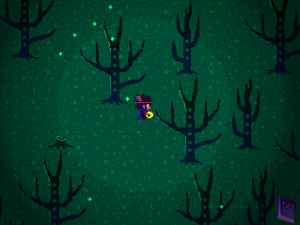 This is not the only way the game messes with game conventions. The story revolves around multiple worlds, one of which is our own. On more than one occasion, the answer to a puzzle is to be found within the game files, with one action actually triggering the creation of a new file containing a clue. This breaking of the fourth wall led me to be much more invested in the game than normal, as did a bunch of other clever and baffling puzzles, and a story that led to a satisfying conclusion.
This is not the only way the game messes with game conventions. The story revolves around multiple worlds, one of which is our own. On more than one occasion, the answer to a puzzle is to be found within the game files, with one action actually triggering the creation of a new file containing a clue. This breaking of the fourth wall led me to be much more invested in the game than normal, as did a bunch of other clever and baffling puzzles, and a story that led to a satisfying conclusion.
To find out what it looks like when an RPG is not an RPG, download the game from the RPG Maker website.






